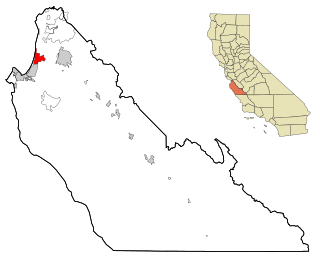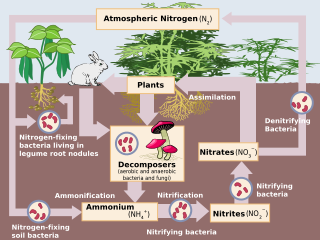Related Research Articles

Marina is a city in Monterey County, California, United States. The United States Census Bureau estimated its 2019 population at 22,781. Marina is located along the central coast of California, 8 miles (13 km) west of Salinas, and 8 miles (13 km) north of Monterey. Marina is on California State Route 1 between Monterey and Santa Cruz. Marina is at an elevation of 43 feet. Marina was incorporated in 1975 and is the newest city on the Monterey Peninsula. The city includes part of the California State University, Monterey Bay campus, UC Santa Cruz UC MBEST center, and the Veterans Transition Center (VTC). In 2012, Marina was named one of the 100 Best Communities for Young People by America's Promise Alliance. The Fort Ord Station Veterinary Hospital, built in 1941 to provide healthcare for U.S. Army horses and mules, was listed on the National Register of Historic Places in 2014. This is the first such official recognition on old Fort Ord. Now knows as the Marina Equestrian Center, has been operated by the Marina Equestrian Association since 1994 when the property was seeded to the National Park Service. The association serves hundreds to thousands of visitors a year who come to enjoy the vast trail systems or to just meet equines up close and personal.

Hydroxylamine is an inorganic compound with the formula NH2OH. The pure material is a white, unstable crystalline, hygroscopic compound. However, hydroxylamine is almost always provided and used as an aqueous solution. It is used to prepare oximes, an important functional group. It is also an intermediate in biological nitrification. In biological nitrification, the oxidation of NH3 to hydroxylamine is mediated by the enzyme ammonia monooxygenase (AMO). Hydroxylamine oxidoreductase (HAO) further oxidizes hydroxylamine to nitrite.

Nitrification is the biological oxidation of ammonia to nitrite followed by the oxidation of the nitrite to nitrate occurring in separate organisms or direct ammonia oxidation to nitrate in comammox bacteria. The transformation of ammonia to nitrite is usually the rate limiting step of nitrification. Nitrification is an important step in the nitrogen cycle in soil. Nitrification is an aerobic process performed by small groups of autotrophic bacteria and archaea. The two step process was discovered by the Russian microbiologist Sergei Winogradsky in 1890.

Marina Abramović is a Serbian conceptual and performance artist, philanthropist, writer, and filmmaker. Her work explores body art, endurance art and feminist art, the relationship between the performer and audience, the limits of the body, and the possibilities of the mind. Being active for over four decades, Abramović refers to herself as the "grandmother of performance art". She pioneered a new notion of identity by bringing in the participation of observers, focusing on "confronting pain, blood, and physical limits of the body". In 2007, she founded the Marina Abramović Institute (MAI), a non-profit foundation for performance art.

The Nitrosomonadales are an order of the class Betaproteobacteria in the phylum "Proteobacteria". Like all members of their class, they are Gram-negative.
Nitrosomonas europaea is a Gram-negative obligate chemolithoautotroph that can derive all its energy and reductant for growth from the oxidation of ammonia to nitrite and lives in several places such as soil, sewage, freshwater, the walls of buildings and on the surface of monuments especially in polluted areas where the air contains high levels of nitrogen compounds.

Nitrosomonas is a genus of Gram-negative bacteria, belonging to the Betaproteobacteria. It is one of the five genera of ammonia-oxidizing bacteria and, as an obligate chemolithoautotroph, uses ammonia as an energy source and as a carbon source in presence of oxygen. Nitrosomonas are important in the global biogeochemical nitrogen cycle, since they increase the bioavailability of nitrogen to plants and in the denitrification, which is important for the release of nitrous oxide, a powerful greenhouse gas. This microbe is photophobic, and usually generate a biofilm matrix, or form clumps with other microbes, to avoid light. Nitrosomonas can be divided into six lineages: the first one includes the species Nitrosomonas europea, Nitrosomonas eutropha, Nitrosomonas halophila, and Nitrosomonas mobilis. The second lineage presents the species Nitrosomonas communis, N. sp. I and N. sp. II, meanwhile the third lineage includes only Nitrosomonas nitrosa. The fourth lineage includes the species Nitrosomonas ureae and Nitrosomonas oligotropha and the fifth and sixth lineages include the species Nitrosomonas marina, N. sp. III, Nitrosomonas estuarii and Nitrosomonas cryotolerans.
Hydroxylamine oxidoreductase (HAO) is an enzyme found in the prokaryote Nitrosomonas europaea. It plays a critically important role in the biogeochemical nitrogen cycle as part of the metabolism of ammonia-oxidizing bacteria.
Nitrospirae is a phylum of bacteria. It contains only one class, Nitrospira, which itself contains one order (Nitrospirales) and one family (Nitrospiraceae). It includes multiple genera, such as Nitrospira, the largest. The first member of this phylum, Nitrospira marina, was discovered in 1985. The second member, Nitrospira moscoviensis, was discovered in 1995.
Hydroxylamine dehydrogenase (EC 1.7.2.6, HAO (ambiguous)) is an enzyme with systematic name hydroxylamine:ferricytochrome-c oxidoreductase. This enzyme catalyses the following chemical reaction
Ammonia monooxygenase (EC 1.14.99.39, AMO) is an enzyme, which catalyses the following chemical reaction
Nitrosomonas aestuarii is a gram-negative, aerobe, bacterium from the genus of Nitrosomonas which metabolize ammonia to nitrite for its source of energy.
Nitrosomonas communis is an ammonia-oxidizing, gram-negative, bacterium from the genus of Nitrosomonas which was isolated from the rhizoplane of the reed from a wastewater treatment plant.
Nitrosomonas eutropha is an ammonia-oxidizing, Gram-negative bacterium from the genus of Nitrosomonas.
Nitrosomonas halophila is an ammonia-oxidizing, aerobe, Gram-negative bacterium from the genus of Nitrosomonas. Nitrosomonas halophila uses the enzyme Ammonia monooxygenase.
Nitrosomonas nitrosa is an ammonia-oxidizing, aerobe, gram-negative bacterium from the genus of Nitrosomonas.
Nitrosomonas oligotropha is an ammonia-oxidizing, aerobe, gram-negative bacterium from the genus of Nitrosomonas which occurs in chloraminated drinking water systems.
Nitrosomonas ureae is an ammonia-oxidizing, aerobe, gram-negative bacterium from the genus of Nitrosomonas.

Nitrapyrin is an organic compound with the formula ClC5H3NCCl3. It is a widely used nitrification inhibitor in agriculture as well as a soil bactericide and has been in use since 1974. Nitrapyrin was put up for review by the EPA and deemed safe for use in 2005. Since nitrapyrin is an effective nitrification inhibitor to the bacteria Nitrosomonas it has been shown to drastically the reduce NO2 emissions of soil. Nitrapyrin is a white crystalline solid with a sweet odor and is often mixed with anhydrous ammonia for application.
Nitrosomonas halophila is an ammonia-oxidizing bacterium from the genus of Nitrosomonas.
References
- ↑ LSPN lpsn.dsmz.de
- ↑ Straininfo of Nitrosomonas marina
- ↑ UniProt
- ↑ eol
- ↑ George M. Garrity: Bergey’s manual of systematic bacteriology. 2. Auflage. Springer, New York 2005, Vol. 2: The Proteobacteria Part C: The Alpha-, Beta-, Delta-, and Epsilonproteabacteria, ISBN 0-387-24145-0
| | This Betaproteobacteria-related article is a stub. You can help Wikipedia by expanding it. |